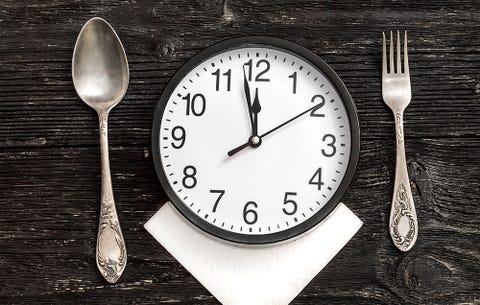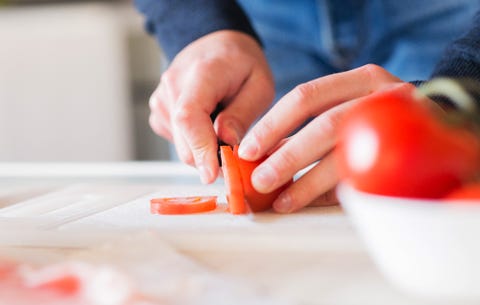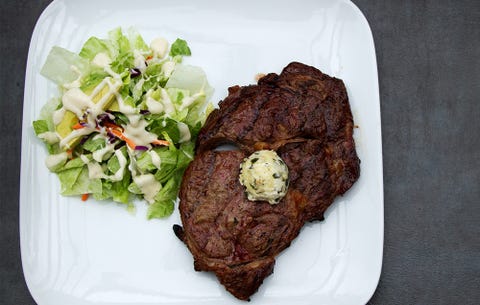Dieting is a popular Reddit topic and many turn to the message boards asking for weight loss and workout tips/tricks that actually work.
On multiple threads, people share which habits made a meaningful impact in their weight loss efforts. Although respondents are from everyday users, many of the tips have a strong backing in science.
We looked to Reddit for the best weight loss strategies that helped real people shed pounds. Try them out and see if they work for you, too.
“Drink water instead of soda.”

Getty Images
It’s a simple, but effective, swap. Nixing empty, liquid calories—like soda, booze, and sugary coffee drinks—will make a big impact.
Soda is loaded with sugar and potentially sketchy ingredients. For instance, one can of Coke contains 39 grams of added sugar (more than your daily recommended max of 36 grams) and 140 calories. Just one a day will save you nearly 1,000 extra calories a week.
Plus, drinking the sweet stuff might increase your risk of some serious health conditions. One study published in the Journal of Nutrition suggests that people who sip sugary drinks like soda have 10 percent more visceral fat—the fat you can’t see hiding deep within your body around your organs—than people who avoid the stuff. This type of fat has been linked to heart disease and diabetes.
“Meal prep will change your life.”

Getty Images
If you have a hard time making healthy food choices in the moment, prepping meals ahead of time can save you from those impulsive not-so-great decisions.
Hectic work schedules and family commitments make it hard to turn down fast food or frozen meals that can be made in minutes. Taking a day or two out of your week to prep will ensure that your meals are full of muscle-building protein, filling fiber, and healthy carbs and fats—all essentials when you’re looking to drop pounds.
Check out our beginner’s guide to meal prep for the basics on getting started—and avoid these mistakes if you want meals that taste fresh and delicious for longer than a day.
“Intermittent fasting. It's been 8 weeks. I’ve lost 18 pounds.”

Getty Images
More than one person on Reddit gave a shout out to intermittent fasting. Basically, your eating is restricted during set times and you eat as normal—or even more than you would otherwise—during others.
In fact, intermittent fasting is just as effective for weight loss as daily calorie restriction, according to a study from the University of Illinois at Chicago. In this experiment, people who fasted ate 25 percent of their daily calorie needs every other day, known as “fast days.” On their “feast days” they ate 125 percent of their calorie needs. So if you typically eat 2,000 calories a day, you’d eat 500 calories one day, followed by 2,500 the next.
Any diet can work—as long as you’re consistent and able to stick with it. “The people who can benefit from this type of alternate-day fasting are those who would rather feel like they aren’t restricting food intake 3.5 days out of the week,” Men’s Health nutrition advisor, Alan Aragon, M.S. told us. That means you find it hard to stick to a diet all the time, and you’d like the flexibility that feast days can give you.
“One sustainable change at a time.”

Getty ImagesJaromir Chalabala / EyeEm
Overhauling your diet and fitness routine can be daunting, which is why Reddit user p-nutz encourages people to start with just one small tweak. For example, make your goal to walk every day rather than to run three miles. “After a while that will be normal,” the Redditor writes. “Then tackle any mindless eating until that’s normal. Eat healthier food until that’s normal. Count calories until it’s second nature, maybe start paying attention to macros after a while, join a gym or pick up that hobby you’ve been wanting to try,” they explain.
In 2009, a combined task force made up of the American Society for Nutrition, Institute of Food Technologists, and International Food Information Council, concluded that small changes were the best way to tackle obesity. This is because small tweaks, like walking everyday, are easy to maintain.
“Go slow.”

Getty ImagesTetra Images
Although everyone wants the pounds to come off the instant they adopt healthy habits, quick weight loss isn’t necessarily the best as it can be hard to maintain and result in muscle loss.
“It's frustrating in the moment, but much more satisfying over time than yo-yo crash dieting,” says Redditor verascity, who lost 60 pounds.
“Not drinking any calories makes a huge difference.”

Getty ImagesLauren King / EyeEm
Although smoothies or protein shakes may seem like a healthy choice, they don’t always keep you satisfied. Redditor lazerdude07 attributes this small tweak with making a significant change in his weight loss efforts.
As Men’s Health previously reported, liquids empty out of your stomach in less than an hour while solid foods take two to four hours. Plus, blending foods pulverizes their fibers and your body breaks them down faster, reducing satiety.
“All you really need is decent movement everyday.”

Getty Images
“I lost 40 kg a few years ago,” one user wrote—that's the equivalent of 88 pounds. “The only thing that really worked for me was to do cardio every single day, just 30 min of good cardio a day.”
The user added: “All you really need is decent movement every day. Jumping jacks are really effective for weight loss, they helped me most.”
Cardio can feel like a chore (unless you try one of these awesome indoor cardio workouts), but according to a study in BMC Public Health, overweight people who included both cardio and weight training into their 12-week exercise program lost more body fat than those who stuck to just one or the other.
“Cook all your own food.”

Getty Images
“Don’t eat anything that comes out of a bag, box, or restaurant,” one user pointed out in the thread.
It’s a good point: One study from the U.K. found that people who ate more than five home-cooked meals per week were 28 percent less likely to have an overweight body mass index (defined as anything above 25) and 24 percent less likely to have excess body fat than those who ate less than three home-cooked meals per week.
That’s because people who whip up their own meals tend to use healthier prep methods, eat a larger variety of foods (like fruits and vegetables), and eat less processed foods, which tend to be higher in added sugar and calories, the researchers note. What’s more, cooking at home motivates you to add other healthy habits into your daily routine, like exercising regularly.
“Include fruits and vegetables with every meal.”

Getty Images
You’re probably not eating enough fruits and vegetables, according to data from the Centers for Disease Control and Prevention (CDC). Only 12 percent of Americans eat at least 1.5 to 2 cups of fruit, while only 9 percent down a minimum of 2 to 3 cups of vegetables a day.
But filling your plate with fruits and vegetables is crucial if you want to eat more food while downing fewer calories. (Two cups of broccoli serves up only 109 calories. Compare that to just one cup of white pasta, which gets you around 200 or more.) Fruits and vegetables also contain lots of gut filling fiber, which will help keep your hunger at bay between meals.
Plus, packing in colorful produce can reduce your risk of chronic health issues, like heart disease, type 2 diabetes, obesity, and even come cancers, says the CDC report.
Try this: Fill half your plate with fruits or vegetables, and split the other between quality carbs (like whole grains) and lean protein for a satisfying meal, Wesley Delbridge, R.D., spokesperson for the Academy of Nutrition and Dietetics, told Men’s Health recently.
“Keto has worked for me. But mostly because it helps me reduce my calorie intake."

Getty Images
The ketogenic diet is all anyone can talk about lately—but it’s not exactly new. The keto model is similar to the Atkins diet of the early 2000s, but focuses more heavily on carb restriction. When you go keto, 60 to 80 percent of your diet is composed of fat, 10 to 15 percent comes from protein, and less than 10 percentis made up of carbs.
Here’s the thing: Keto is extremely restrictive, which automatically means it won’t work for everyone. But if you can stick with it, you should go into in a ketogenic state, which will theoretically force your body to run on fat rather than glucose (a type of sugar found in carbs), helping you burn fat by default.
Plus, as the Reddit user noted, you’re forced to eat a limited number of foods, which means you have less of any opportunity to rely on unhealthy options. Plus, you can’t really eat carbs, so you will immediately eliminate refined carbs, like sugar cereals and packaged snacks, which can help you reduce your calories.
Here’s everything you need to know about keto before you try it, including three tips that will prime you for success. This ketogenic diet meal plan will serve some recipe inspiration, too.
Associate Editor Alisa Hrustic, an associate editor at Prevention, has spent her entire career interviewing top medical experts, interpreting peer-reviewed studies, and reporting on health, nutrition, weight loss, and fitness trends for outlets like Women’s Health and Men’s Health, where she both interned and worked full-time.
Melissa Matthews Health Writer Melissa Matthews is the health writer at MensHealth.com and has written for Newsweek, Men's Fitness, Inc.
Source: https://www.menshealth.com/weight-loss/a19546863/reddit-weight-loss-tips-that-work/












